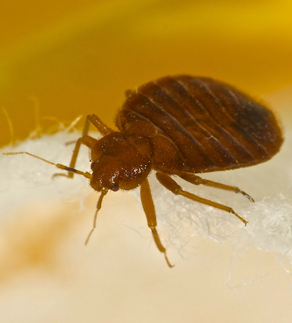Treating for Bed Bugs
Bed bugs are insects that feed exclusively on blood. Humans are the preferred host of the Common Bed Bug, Cimex lectularius. While bed bugs are currently not known to transmit diseases, their feeding may cause itchy bites, raised welts, irritation and other maladies of their human hosts. The Environmental Protection Agency (EPA) considers bed bugs a public health because infestations can have a significant effect on humans where they occur.
Bed bugs do, in fact, cause public health issues including but not limited to itchy bites, welts, allergic reactions, skin conditions, sleeplessness, social stigma and anxiety of bite victims. Once an infestation begins, bed bugs can become a serious pest, which is difficult to eliminate. Those concerned about bed bugs should learn the proper information about their prevention and control. If you suspect a bed bug infestation, it is best to find it early, before it becomes established, grows or spreads.
How Do You Know if You Have Bed Bugs?
Bed bugs can be challenging to identify. Bites on the skin are a poor indicator of a bed bug infestation, as they can look like bites from other insects (such as mosquitoes or chiggers), rashes (such as eczema or fungal infections), or even hives. To identify bed bugs, it is best to look for the telltale signs of bed bugs which include fecal stains, shed skins, eggs, carcasses or the live bed bugs themselves.
Fecal stains may appear as dark spots on bedding, mattresses, box springs and other areas where bed bugs are active. The color of these spots may range from a rusty red to black. They will often smear, which may reveal red, when suitably touched. Bed bugs shed their skin when they molt to grow to the next life stage or size. When found intact, these shed skins appear as a hollow insect. However, small pieces of shed skins may also be found. At about one millimeter, or about 1/25th of an inch, viable bed bug eggs are small, oval like and pearly white. They are rounded at one end and flattened at the other. Hatched eggs appear hollow, yellowish to white and translucent. Bed bug carcasses are simply deceased bed bugs. Note that bed bugs may vary in size from about 1/8th of an inch to about 3/8th of an inch for adults.
Treat Bed Bugs Before They Become a Major Problem
Experts agree that it is far easier to eliminate a small bed bug population than a large infestation. This is why inspection and early detection is important. Treating a minor infestation, while an inconvenience, is far less costly and easier than treating the same infestation after it becomes more widespread. When a bed bug infestation is discovered, there are multiple methods for controlling it, including both chemical and non-chemical approaches. While using one or the other works, it has been found that an approach that uses a combination of both can be more effective. Using this combination of approaches is often referred to as integrated pest management.
Hiring a pest management professional is a good option in many cases, but you need to be careful in how you select a company. APS has a team of dedicated technicians trained to combat bed bugs, each with over 1,000 hours of experience in this trade. Our methodologies were developed in consultation with one of the pest management industry’s leading and well known bed bug experts. We work closely with each individual client to determine the best options for their treatment, offering help and advice every step along the way: from pre-treatment to post treatment-clean-up. We follow through with each bed bug case until the infestation is completely resolved. If you have concerns about bed bugs or believe you have a bed bug problem, contact us today to find out how we can help!





